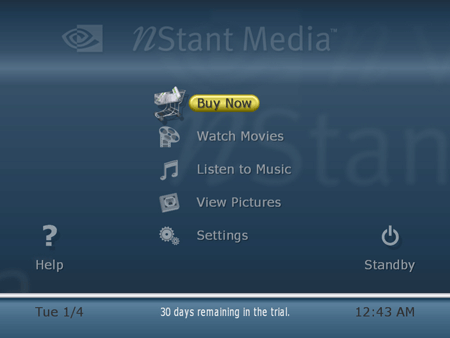High definition is the future entertainment standard of tomorrow's video's.
Playing high definition content on current generation PCs can boggle down even
the fastest processors because there is more data to handle. Similar to the need
for DVD accelerators a few years ago, nVIDIA PureVideo enables computer users to
view MPEG-2/DVD and WMV HD formats without slowing the PC to a crawl.
The PureVideo standard incorporates a hardware accelerator for the afore
mentioned MPEG-2/DVD, and Microsoft Windows Media HD Video standards (WMV HD).
According to nVIDIA's documentation on PureVideo, the GPU (GeForce 6 and 7
series GPUs) takes on video decoding tasks from the CPU, and the end result is
smoother, shutter free HD playback. nVIDIA PureVideo also supports most current
and future high definition formats. The system seems to be built with a good
degree of future proofing for upcoming standards.
PureVideo is more than just a media accelerator; it also includes features to
improve video picture quality. DVD, cable and satellite video provide poor
crispness, clearness and smoothness that consumers have been desperate to be
"saved from." nVIDIA's PureVideo technology applies spatial temporal
de-interlacing to apparently deliver a better image than traditional
de-interlacing can muster. PureVideo also fixes the 3:2 pull down problem that
can arise from 24 fps video being converted to 30 fps for viewing on TVs or
monitors. By recovering the original 24 frame content, PureVideo allows for a
clear crisper image.
Another neat feature of PureVideo is its ability to scale videos to any
resolution, while maintaining a relatively detailed picture. This means users
can view lower resolution videos at a high resolution without suffering too much
from blocky or blurry pictures.
To test PureVideo's HD accelerating capabilities, we decided to play one
video through Windows Media Player 10, which was downloaded from Microsoft's WMV HD Content Showcase. The Discoverers (IMAX)
video is available in both 720P and 1080P formats and CPU utilization was read
through Task Manager.

When the 720P version of the Discoverers high definition video is played
back through the onboard GeForce 6150 videocard, there is an immediate spike to 100% CPU
usage, but that drops within a second to normal operating range. Throughout the whole
video CPU usage jumped between 25 and 36%.

Running the 1080P version of the video produced similar results. Of
course considering that the 1080P version of the video has higher details, CPU usage
jumped between 45-60%.
nVIDIA PureVideo Decoder Software
Sold
separately is nVIDIA's PureVideo Decoder software (retails for between $20-$50 US) which functions with any GeForceFX/6/7 series videocard. The software essentially turns a desktop PC into a home entertainment center with the ability to watch DVD movies or other computer related videos, listen to music or view pictures.

The look and feel of nStant Media is very
similar to Microsoft WindowsXP Media Center's media browser. Under the 'Watch
Movies' category, users can watch videos stored on the HDD or on disc. 'Listen to Music' has the same options as does 'View Pictures.' The 'Settings' options allow users to change language, when the nVIDIA screen saver kicks in, parental control, closed captioning, display formats (Standard definition or high), etc. Overall the look and feel of nStant Media is nice and the program is extremely easy to use.
|
experts tip: trial software and
dates |
| when testing the nvidia's PureVideo Decoder software 30 day trial, be sure not to adjust the date unless you are sure you intend to purchase the full version. Doing so means the trial version will expire instantly, which cannot be resolved by simply reinstalling the program. So give the application a trial first before deciding if it is right for you. |
| Comments and Feedback? Suggest a
Tweak. |
In our tests with the component output, the image quality was significantly better than S-Video output. While the resolution was not as sharp as what you would see with a regular monitor, medium sized text could be read. With S-Video, only the largest words could be read, everything else was blurry. The onboard GeForce 6150 also supports high definition modes up to 1080P which means video image will be superb when viewing on a high definition television.
